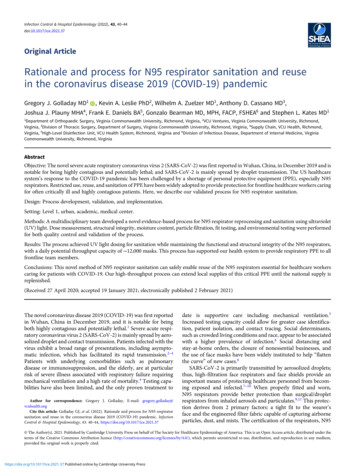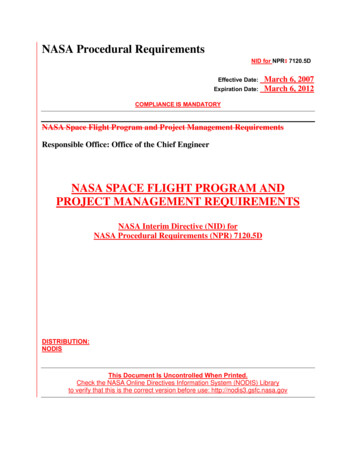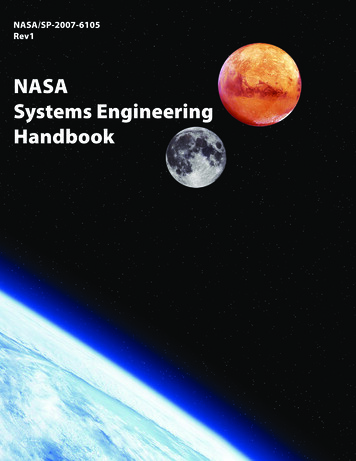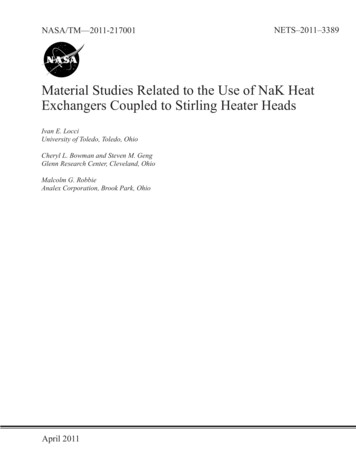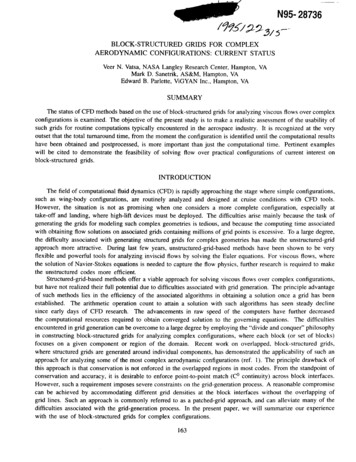
Transcription
N95- IONS:COMPLEXCURRENTSTATUSVeer N. Vatsa, NASA Langley Research Center, Hampton,Mark D. Sanetrik, AS&M, Hampton, VAEdward B. Parlette, ViGYAN Inc., Hampton, VAVASUMMARYThe status of CFD methodsbased on the use of block-structuredgrids for analyzingviscousflows over complexconfigurationsis examined. The objective of the present study is to make a realistic assessment of the usability ofsuch grids for routine computationstypically encountered in the aerospace industry. It is recognizedat the veryoutset that the total turnaroundhave beenobtainedwill be citedtime, from the momentand postprocessed,to demonstrateblock-structuredthe configurationis more importantthe feasibilityof solvingis identifieduntil the computationalthan just the computationalflow overpracticaltime.configurationsPertinentof The field of computationalsuchas wing-bodyfluid dynamicsconfigurations,However,the situation is not as promisingtake-off and landing, where high-lift devicesgeneratingthe grids for modelingwith obtainingthe difficultyapproachflexibleflow solutionsassociatedon associatedDuringanalyzedgeometriesgrids containingstructuredis tedious,at cruisemillionsand becauseconditionswith CFDinviscidflows by solvingthe computingof grid points is excessive.grids for complexgeometrieslast few years, unstructured-grid-basedtools for analyzingthe stage where simple configurations,and designedtools.when one considers a more complete configuration,especiallyatmust be deployed. The difficulties arise mainly because the task ofsuch complexwith generatingmore attractive.and powerful(CFD) is rapidly approachingare routinelyhas mademethodsTo a large degree,the unstructured-gridhave beenthe Euler equations.time associatedshownFor viscousto be veryflows, wherethe solution of Navier-Stokesequations is needed to capture the flow physics, further research is required to makethe unstructuredcodes more efficient.Structured-grid-basedmethods offer a viable approach for solving viscous flows over complex configurations,but have not realizedof such methodsestablished.Thesince earlytheir full potentiallies in the efficiencyarithmeticoperationdays of CFD research.the computationalresourcesrequireddue to difficultiesof the associatedcountto attainassociatedwith grid generation.algorithmsin obtaininga solutionThe advancementsto obtainwith such algorithmsin raw speedconvergedsolutionThe principlea solutionhas seenof the computersto the governingadvantageonce a grid has difficultiesencountered in grid generation can be overcome to a large degree by employing the "divide and conquer" philosophyin constructingblock-structuredgrids for analyzing complex configurations,where each block (or set of blocks)focuseson a givenwhere structuredapproachcomponentor regiongrids are generatedfor analyzingof the domain.aroundindividualsome of the most his approach is that conservationis not enforced in the overlappedconservationand accuracy, it is desirable to enforce point-to-pointHowever,such a requirementimposessevere constraintswork on overlapped,has demonstratedblock-structuredthe applicability(ref. 1). The principlegrids,of such andrawbackofregions in most codes. From the standpoint ofmatch (C O continuity) across block interfaces.on the grid-generationprocess.A reasonablecompromisecan be achieved by accommodatingdifferent grid densities at the block interfaces without the overlappingofgrid lines. Such an approach is commonly referred to as a patched-gridapproach, and can alleviate many of thedifficultiesassociatedwith the grid-generationwith the use of block-structuredprocess.grids for complexIn the presentconfigurations.163paper,we will summarizeour experience
OVERVIEW OF CURRENT CAPABILITYThis sectionis ailedinformationon thesetopicscaneasilybe foundin the openliterature.Grid generationThereis r complexconfigurations,as is evidentby thelarge number of participants in recent conferences on grid-generation(refs. 2-4). Almost all organizationsinvolvedin CFD simulations have some type of in-house grid-generationcapability. For example, AGPS at Boeing, MACGSat McDonnellDouglas,generation systemssuch as GRIDGEN,It is difficultUNISGat Rockwell/FIAT,to list all such activities,flow over a varietythe time, these customersthe configurationavailable.at Canadair,are some of the better knowngrid-currently in use at various industries.In addition, commerciallyavailable software packages,ICEM/CFD,NGP, and GRIDPRO/AZ3000are constantly upgraded to meet customer needs.a CFD user's perspective.As researchersassociatedanalyzeand MBGRIDbeinginstead we briefly discusswith the CFD Laboratoryof configurationsprovideus with only a coarseOn few occasions,Our task as CFD engineersat NASApoint definitiona standardis to provide accurategrid must be generatedgrid-generationtask generallyLangleyfeaturesbeforeCenter,and externalof the individualCADdefinitionflow solutionsthe flow solutionsof some of these tools fromResearchthat are of interest to our internalanalyzed.possible time.A suitablethe generalcomponents( e.g.for a givenpart of the process,toMost ofthat comprisein IGES format)over such configurationscan be computedturns out to be the most time-consumingwe are requiredcustomers.may bein the shortestconfiguration.particularlyThein terms ofman-hours.Given enough lead time, most of the commercial grid-generationsystems cited earlier in this paper canbe used to create good quality grids, especially by their originators.However, these software packages are quitecomplexto use and invariablygood qualitygridsrequirein a timelymanner.steps and paths that are traveledcan be overcomeby creatingan expertvia complicateda centeruser (who probablydoes grid generationThe fact that these tools are heavilymenu-drivenof expertisebranches,in an organization,for a living) to createinteractive,with a large numberkeeps the novicesofat bay. This difficultybut then one has to face the consequencesof compartmentalizingone facet of the solution process from the rest. It is well known that the grid density isdetermined by the particular algorithm and application, which in turn requires coordination between grid-generationand flow-solutionorganizations.be usableand analysisphases.Such arrangementsThe point to be emphasizedby an averageengineerinvolvedprocessstartsfull potential.The grid-generationmay not be practicalin flow simulationwith surfaceactivities,modeling,afteravailable.These geometric definitions can take many forms, rangingas NURBS, to a collection of points measured directly from a physicalavailable,surfacewhich is generallywith high fidelity.the case, smoothIn general,except in large, production-orientedhere is that until the grid-generationand accurateCAD-basedsurfacesystems,processCFD as a surface intersectionsthe expertisefor average(throughCFDAccuratedescriptionOnce again, CAD-basedof geometricallycomplexinterpolationsare requiredsuch as ICEM/CFD,user training)engineerrequiredto maintainof the intersectionsgeometricenoughtowill not achieveitsdefinitionsbecomefrom parametric surface definitions, suchmodel. If only a coarse point definition isis essentialto create an enrichedhave a definitesurface modelingstage. Usually the surface definition of only the individual(e.g. wing, fuselage, tail ) is provided, and it is left up to the CFD engineerthe variousis simplifiedcomponentsto determineadvantageat theof the configurationthe intersectionsoffor maintainingthe fidelity of thesystems are generally more flexible and accurate for computingcomponents.Such flexibility comes at the added cost of acquiringto navigateproficiency.throughSince164a CAD system,surfacemodelingwhichis generallyis only a smallparttoo complexof the total
grid-generationprocess,a morecosteffectivewayto accomplishsucha taskisthroughmaintaininga centerofexpertise, such as GEOLABat NASA Langley Research Center.After the surface modeling is completed, the detailed grid-generationprocess begins by selecting grid topologiesfor the surface and field grids. For multiblock grids, this requires splitting the physical domain into different blocks(zones), a process which is commonly known as domain decomposition.Most grid-generationpackages rely veryheavily on interactive, user-suppliedintuition to arrive at the blocking strategy (domain decomposition),both at thesurfaceand field grid levels.control of blockingconfigurations,The interactivestrategies.However,since accurateprovidessuch an approachvisualizationutmost flexibilityof blocks requiredvisualizationTo exacerbatefor griddingmatters,to the user becauseis very tedious, especiallyof the block boundariesdue to the large numbersoftware.approachcomplexespeciallyin physicalfor complexconfigurationsThis is mainlyand due to limitationsgrids,a changefullthree-dimensionalspace is cumbersome.for C O continuousit allowsof availablein blockstructureintended for a given zone can cascade into a series of changes affecting several other zones, increasing the effortrequired to complete the grid-generationtask.Based on our experience,a batch-orientedapproach is needed to make the block-structuredgrid-generationprocess more attractive to engineering users. The interactive means, especially graphical user interfaces (GUI's) canand should be used to help the user set up the input to the grid-generationcode and to help make decisions relatedto topologyand domainand editabledecomposition.must be able to specifygrid-generationpackage5). The domainan interactivemoduleis invoked,an easily understandableso that it can be added to the batch input file later on. Of course,the usergrid density and grid spacings in various zones and subzones. Recently, a batch-orientedwith semi-automaticblocking capability was developed by Eisemann and co-workers(ref.decompositionin their softwarespecificationof the block structuremove freelyand evolvecoordinates.The resultingby cornersBut, wheneverscript file should be createdsimultaneously(knowntopologicalwith the solutiongrids are relativelyof the grid blocks.packagein a parametricAlthoughas GRIDPRO/AZ3000)space.to the partial-differentialsmooth and nearly orthogonal,it is a promisingmethod,is accomplishedThe zonal boundariesequationsthat governexcept near the singularin our opinion,throughin the physicalseveralspacethe gridpoints formedshortcomingsof thisapproach (addressed later in the paper) need to be rectified before this software package can be used routinely byCFD engineers working on aerodynamicflow problems.Before closing the discussion on grid generation,it should be mentioned that the specificationof boundaryconditions,especiallysuch a coupling,rapidlythe block-interfaceshould be integratedtoo much user time is spent on preparingwith the increasecapabilityconditions,in the numberwould also reducethe input to flow solvers, and the chanceof zones (blocks)the need for humanwould form the core of a completelast few years,Reynolds-averagedstructured grids.CFL3D,INS3D,laboratoriesBoeing,PAB3D,and TLNS3DGrumman,at the Europeansimilar codesfor theirRockwell,Spaceown internalIn addition,GeneralAgencyin the numberfor steadyat NASAuse.This type ofto flow solvers,whichcodes capableof solvingflows over complex configurationscenters, most notably OVERFLOW,on blockNPARC,to variousDLRThe capabilitiesof computerindustries,the large aerospaceElectric,(ESA),of errors increaseSolvershave been distributedthe United States.Withoutsystem.growthNavier-Stokes(RANS) equationsSeveral multiblockcodes developedthroughoutNorthrop,Researchersthere has been a steadyprocess.of the grid topology.in linking the grid generationsoftwareFlowDuringand the complexityinterventionCFD analysiswith the grid-generationand Pratt & Whitney,(Germany),universities,companies,have their own customizedand RAE (England)of the variousand other federalsuch as McDonnellcodesdifferDouglas,codes.have also developedsomewhat,dependingonthe original application for which each code was developed.However, most of the mature codes are capable ofhandling the complex aerodynamicconfigurationsof practical interest if suitable grids are available.Before proceeding further with the discussion on flow solvers, it is appropriate to classify different types ofblock-structuredgrids, basedon the connectivitypresent165at the block(zonal)interfaces.In overlapped(overset)
pedregioninsteadof aclearlyidentifiablezonalinterface.In patchedgrids,theadjoiningblocksforma commoninterface,butthepointdistributionon theblockboundariesthat form the interfaceis different. In COcontinuousgrids,the adjoiningblocksthatform the interfacehaveapoint-to-pointmatchat andtheCOcontinuousgridsforma hierarchyof structuredgridsrequiringincreasedeffort in ffort to generate.However,with regardto flow solvers,COcontinuousgridsarethe simplestandmostconvenientto deal with.Theoverlappinggridsareby far theeasiesttypeof gridsto ionsonthemostcomplexgeometriesto guration(ref. 1). However,conservationis notenforcedin theoverlappedregionsof the grid; thereforethis methodologymaynot be appropriatefor problemsin whichaccuratecapturingof shocksandsheardiscontinuitiesis crucial.Furthermore,theactualprocessof elagejunctureregionsfor adequateresolutionof the boundarylayers. In addition,a varietyof preprocessorsareneededto determinethe connectivityandinterpolationcoefficientmatrixfor the overlappedgrids, whichrequiressignificanthumaninterventionbeforeCFD analysiscanbeperformed.Thenextstepin the block-structuredgrid hierarchyis the patched-gridapproach,wherethe zonalboundariesdo not overlapbut havedifferentgrid distributionin the adjacentzones.Considerableresearchhasbeendoneon patched-gridalgorithmsto achieveconservationatzonalinterfaces.Althougha conservativealgorithmcanbedevisedmoreeasilyfor patchedinterfacesthanfor overlappedgrids,this taskis still not trivial, s.6-9). Dueto thedifficultiesencounteredin al-purpose3-D flow nterfaces.Forreasonsdiscussedpreviously,useof theCOcontinuousmeshesis preferablewheneverpossibleto dly,thisshiftstheburdenof CFDsimulationsto gridgeneration.Werealizethatthe generationof Co continuousgridsfor complexconfigurationsis a difficult task; however,theadvantagesof usingsuchgridsin termsof licityof encyofzonalinterfacesin suchgridsis fairly straightforward.Availabilityof elatederrorsis extremelyhelpfulto CFDengineers.However,dependingonthe levelof complexityofthegeometricconfiguration,the C O constraint on grids may need to be relaxed, especially to make more efficientuse of grid points and to improve the overall grid quality (smoothness and orthogonality).By placing the patchedgrid interfaces away from strong discontinuities,the errors caused by the loss of conservationat such boundariescan be minimized.SELECTEDA in-layerform of the Navier-Stokesflow is assumedA five-stagehas been employedto be fully turbulent,Runge-Kuttaat the odd-numberedto increasetime-steppingstagesthe stabilitymultiblockAPPLICATIONSNavier-Stokescode TLNS3D-MB,to obtainflow solutionsequationsis used for modelingand the effect of turbulenceschemedevelopedon several configurationsthe mean flow.is modeledwith three esidualin convergenceinterest.otherwise,the eddy-viscosityof the artificialenhancementof practicalUnlessis used to advance the flow solution in pseudo time. Implicitof the time-steppingat NASA LangleyThethehypothesis.terms computedsmoothingis usedof the time-steppingscheme is achieved via a multigrid acceleration technique. The details of the numerical algorithm used in TLNS3DMB are available in references10-11. This code has been calibrated through a wide variety of applicationsbyseveral independentresearchers(refs.12-15).For a flow code to be accepted by the research community at large, it must be capable of providing accuratesolutions for problems of interest in a timely manner. To a large degree, the accuracy of a flow solver depends166
on the explicitresearch,and implicitit was concludedlevelsof artificialthat the accuracydissipationinherentin the numericalof the central-differenceschemescheme.is greatlyBasedenhancedon our earlierby using a matrixtype of artificial dissipation model instead of a scalar dissipation model (ref. 16); hence, the matrix dissipationmodel has been used for the computations presented here. Another key element that determines the overall accuracyof a CFD code is the ability of the underlying turbulence model to capture the pertinent flow physics. If a flowsolver has a turbulencemodel that fails to accurately predict the important flow features, it will not meet therequirementsseparationof CFD volved in the design process.locations,and boundary-layerIn addition,one another.Basedthe turbulencemodelthe blocks,therebyachievingconvergencein the computationalof codingrequiredconstraintsefficiencyin a multiblockcode.to retain the vectorizationsolutionsof the overheadsurfacesof aerodynamicsassociatedalso enhancesisthatturbulenceproblems,the communicationto use the largest blockSuch a strategygradientsmultipleto the single block implementation.becauseIt is preferredefficiency.to minimizepressurethe one-equationfor a wide varietycarefullythe ability to predictof strongand our own experience,levels comparableis inevitableapplications,in the presenceshould be able to accommodateon both a literature surveymodel of Spalart-Allmaras(ref. 17) can produce accurateand has been used in the current applications.The multiblock structure in this code was constructedpenaltyFor aerodynamicpropertieslag betweenOf course,somewith the added complexitysizesubjectthe implicitnessto the geometricof the numericalscheme by increasing the domain over which the implicit operator of the residual smoothing is effective.Theseissues are discussed in detail with specific examples by Vatsa, Sanetrik, and Parlette (ref. 10). In the next section,severalapplicationsof this method to problemsof generalinterest are discussed.Multi-elementDuringnumberlandingof airfoiland takeoffsections.maneuvers,For structuralmost aircraftas a result of a joint effortCo. for a two-dimensional,has been used successfullyshownbetweena wing configurationreasons,that consiststhese componentsare placedof a multipleextremelyclosespecial problems in the constructionof suitable structuredgrids,test case representativeof realistic high-lift configurationis nowNASALangleyResearchCenterand McDonnellDouglasAircraft3-element high-lift configuration.The newly available GRIDPRO/AZ3000softwareto grid this configuration(ref. 18). A partial view of the resulting 97-blockgrid ishere in Fig.1. The grid lines are smooththe block boundaries.This grid clearly demonstratesgrids for geometricallycomplexHowever,packagethis softwaredeployand aerodynamicto one another.Such an arrangementcreatesespecially C O continuousgrids. An excellentavailableairfoilconfigurations,and nearlyorthogonal,the flexibilityand in beingexceptnear singularof GRIDPRO/AZ3000able to concentratedoes not lend itself easily to clusteringpointsto generategrid pointsformedbyCFD-qualitynear solid surfaces.grid points in the field away from the solidsurfaces, e.g. along wake lines.The computed pressure distributions for this configurationwere compared with the experimentaldata by Vatsaet. al in reference18. In general, the computed pressures agreed well with the measured data, and the resultingsolutionsindicatedlow velocityconsistenttreatmentfluid was observedof the zonal interfacein the cove regionsthe flap. However, due to poor resolution in the wakewell with the experimentaldata (ref. 18).F/A-18boundaryconditions.As expected,of the slat and the main airfoil,regions,the computedvelocityprofiles 0.34, Ree 11.5x106,on the forebodymergesand c 190 to correspondwith the wing leadingedge.surfaceofofdid not correlateforebody/LEXThe next case that was considered for demonstratingthe current multiblock code capabilityflow over the F/A-18 forebody leading-edge-extension(LEX) geometry.The test conditionsMa large regionand on the upperto flight data (ref.In the simpler167was the viscouswere chosen as19). In the actual geometry,model consideredthe LEXhere, the grid at the end of
theLEX is extendeddownstreamasa shroudof constantcross-section,whichpermitstheapplicationof a simpleextrapolationconditionat the downstreamboundary.Theeffectof this simplificationshouldbe minimalon theflow overthe forebodyandtheLEX.A similarapproachhasalsobeenemployedby Ghaffariet. al (refs.20-21).A partialviewof the 3-blockgrid usedto modelthisconfigurationis shownin Fig. 2. A C-Otypegrid is usedon the forebody(block1),whereasH-O typegridsareemployedin the remainingblocks.The blockboundariesareselectedsothatthe configurationis subdividedintoeasilyidentifiablecomponents.The computationalgrid usedin this studyconsistsof approximately750,000meshpoints. A 3.5 order-ofmagnitudedecreasein theresidualof thecontinuityequationwasobtainedin about325workunits(250fine-griditerations)in reference10, whichis consideredquitegoodfor sucha finemesh,andis significantlybetterthanthe convergencerate associatedwith non-multigridtypeof codes. The globalforce coefficientsconvergedinabouthalf edfavorablywith the experimentaldataandindicatedcorrecttrendson boththeforebodyandtheLEX exceptatthelastaxialstation,wheretheeffectof wingleading-edgemissingin the computationsbecomessignificant(ref. sconsideredin this studyis thatof a genericwing/body/engine/pylonconfiguration.The mainreasonfor selectingthis testcaseis to demonstratetheapplicabilityof ationproblems,typicallyencounteredin advancedsubsonictransport(AST)configurations. Currenthigh-bypass-ratioengineshavea very largefrontalareaandcanhavea significanteffecton theflow fieldon thewingdueto renceeffectscannotbe predictedaccuratelywith simplelinearmethods.The particularconfigurationconsideredhereis a DLR transportaircraftwith a high-bypass-ratioenginemountedon a pylon.Anl 1-blockgrid consistingof approximately550,000meshpointsgeneratedby RossowandRonzheimer(ref. 22)wasusedfor computingthe inviscidflow overthis configuration.A partialviewof this grid is shownin Fig. 3.The testconditionsselectedfor thesecomputationsare Moo 0.75 and cr 0.84 , which are representative ofcruise conditionin referencefor this type of aircraft.10. The computednext (ref. 10), which indicateslies in a different block.To assessThe solutionssurface-pressurea consistentthe effect of the enginefor this case were reportedcontoursand accurateby Vatsa, Sanetrik,were found to vary smoothlytreatmentand Parlettefrom one componentacross block boundaries,and pylon on the flowover the wing, the surfacegto thesince each componentdistributionson two crosssections that lie inboard and outboard of the pylon were compared with the computed pressures on the clean wingand body configurationin reference 10. Based on these comparisons,it was inferred that due to the interferenceeffects caused by the engine and the pylon, the pressureand the shockshiftsforwardon the uppersurfacepeak flattens in the accelerationof the wing, whichhistory for this case was found to be very similar to the F/A-18the residual was achieved in 400 work units (ref. 10).SupersonicCurrentlygenerationthere is an enormousof supersonicmust rely heavilystructuredtransports.on CFD analysisgrid consistinginterestof approximatelylift.The convergencefor developingtechnologyof the high cost of testing a model at flight conditions,the developmentalphase of such vehicles.A 19-block,one million grid points was created to representand the far field was filled with additional blocks.an orderly matching of dissimilar topologies.168decreaseintransportfor demonstratingthe current capability.A partial view of selected surfacesshown in Figs. 4--6, to indicate the structure and topology of the computationalwithin a group of blocks,block corners to facilitatein reducedcase, and a 3.5 order-of-magnitudein United States and elsewhereBecauseduringresultsregion on the lower surface,a proposedfor the nextthe designersC O continuousconfigurationand zones for this configurationaregrid. Each component was enclosedSingu.!ar pointswere introducedat
The Navier-Stokessolutionswereobtainedfor a seriesof anglesof attackat a cruiseMachnumberof 2.4.A typicalrun required3-4 hoursof cputimeon a singleprocessorof theNAS CrayC-90to obtaina beencomparedwiththeexperimentaldata,resultingin excellentagreement.STATUSOF EMERGING CAPABILITYThe flow solverson structuredgridsarein a relativelymaturestageof developmentat onaryour opinionwill havechanges.changes.significantOn the other hand,In this section,impactThebiggestbottleneckwe touch upon the activitiesin the grid-generationa labor-intensivean approachassistinginteractiveserves a usefulprocess.purposein the assessmentprocessadvantagesto batch-orientedand arefield that isin both of these disciplineswork, accessvia input files, and the grid generationcontrolgrid generationdomainat the domaindecompositionstages of grid-generationto the user regardingand disadvantagescan be selectedoffer promise, regardingoccursIn the t ingenerationby giving completeof relativeis a rapidlyon future CFD research.Gridgenerallygrid generationof differentis preferable,can be completeddecomposition.blockingstrategies,in whichHowever,the desiredin an hands-offmanner.issuchtherebyfor routineblockstructureTwo independenthas developedsemi-automatedhexahedralvolume mesher for creating multiblock structured meshes,The user defines the initial structure or lets HEXA initialize the block structure aroundto the ICEM/HEXAcan be either CAD geometry, NURBS surfaces or trimmedcurves. Mesh sizes can be defined on the family of CAD surfaces or individuallywhichdevelopment,strategies.The ICEM/CFDlevel,softwarean object-basedknown as ICEM/HEXA.a given geometry.InputNURBS surfaces and NURBSon the block edges using edgemeshing options.GRIDPRO/AZ3000The grid is projected onto the underlying CAD geometry with minimum user interaction.Thesoftware package of Eisemann (ref. 5), on the other hand, employs a different strategy, in whichthe user specifiesthe blockevolvealongto providestructurewith the solutionin a topologicalparametricto the grid coordinates.space.However,good quality CFD grids. First, the surfacedefinitionThe blockboundariesin physicala few areas must be improvedwithin AZ3000spacefor this softwareneeds a better representationthanthe bilinear patching that is currently implemented.A more flexible control of grid density is also required inpredeterminedregions in the field away from solid surfaces to allow clustering in high-gradientregions, such aswakes. Finally, a user-friendlyinput stream would greatly enhance the usability of this package.A novel grid-generationmethodology has been recently developed by a team of researchers from NASA LangleyResearchCenterand the UniversityDesign(RAPID),aircraftcomponentsof Leeds,a small set of design(solid surfaces)England.parametersare manifestedIn this method,known as Rapid Airplaneand grid parametersthroughsolutiongovernParametricthe grid-generationof a uationsubject to Dirichlet and Neumann conditions.Volume grids are obtained through an applicationof the ControlPoint Method.This technique has been used to generate CFD-qualitygrids on airplane like configurationsthatconsistof wing, fuselage,level of fidelitystudies ratherAlthoughdream,in termsand verticalof surfacerepresentation;tails, and canardshencethan final, detailed analyses.truly automatic hands-off grid-generationsome recentCFD engineershorizontaldevelopmentsare requiredcould23). This techniqueit is more suitablecapabilityprove very helpful(ref.for preliminaryfor completein parametricto study the effect of small geometricchangesprovidesdesignairplanestudies.a mediumconceptualconfigurationsIn manyon the aerodynamicdesignis still aapplications,performanceof aconfiguration.The recently developedMultidisciplinaryDesign Optimizationsoftware package, known as the Coordinate and Sensitivity Calculatorfor(CSCMDO), can be used to generate volumetric grids which reflect smallgeometricgivenchangesin a configuration,a baselineconfiguration169and the grid associatedwith it (ref.24).
This softwareis controlledvia anASCII userinputfile for executionin a batchenvironment.Oncethe grid onthe baselineconfigurationis availablefroman independentsource,CSCMDOprovidesthe userwit
The status of CFD methods based on the use of block-structured grids for analyzing viscous flows over complex configurations is examined. The objective of the present study is to make a realistic assessment of the usability of . ICEM/CFD, NGP, and GRIDPRO/AZ3000 are constantly upgraded to meet customer needs. It is difficult to list all such .

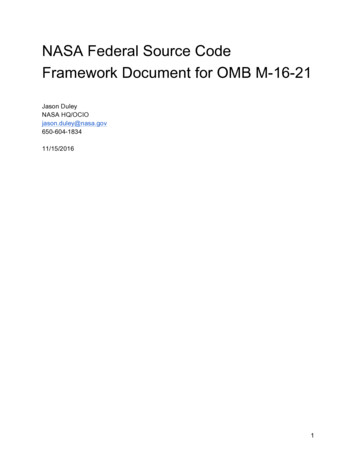
![N95 Respirators Training August 2012 Final - HS [Read-Only]](/img/20/n95-respirators-training.jpg)
